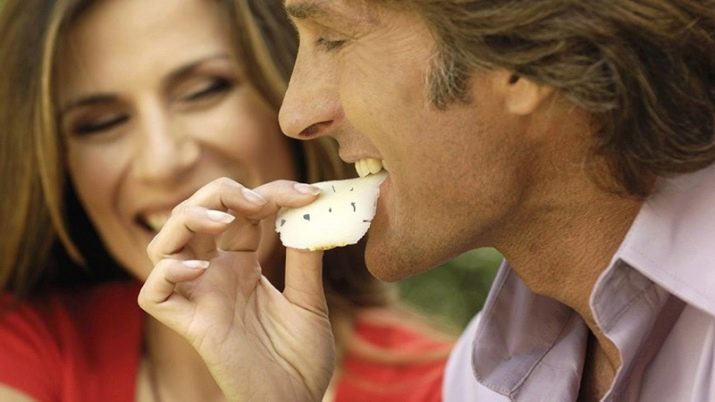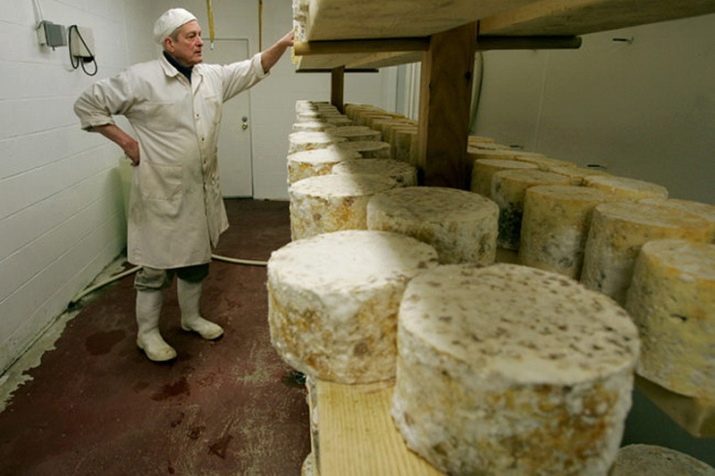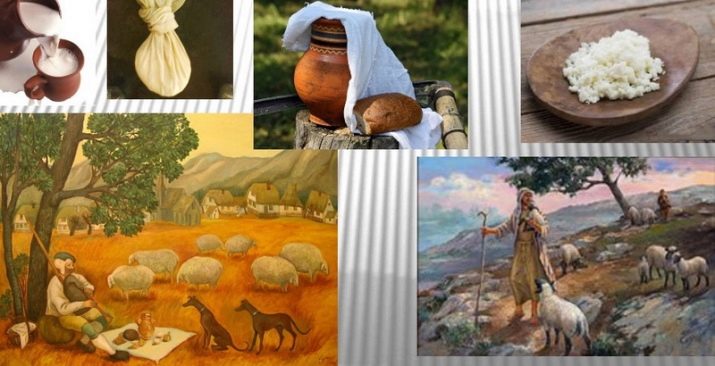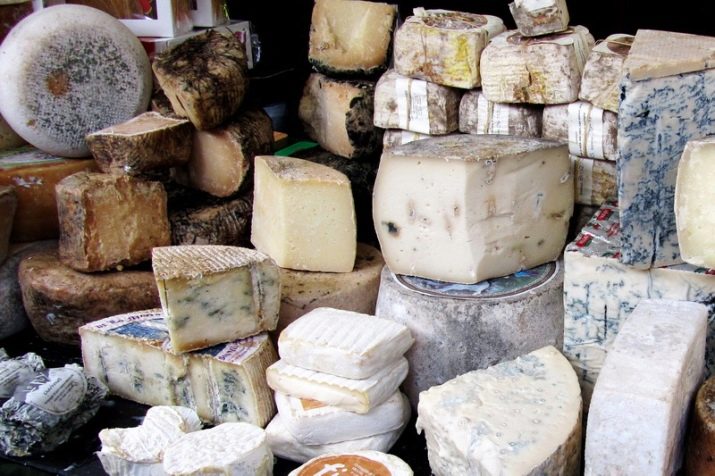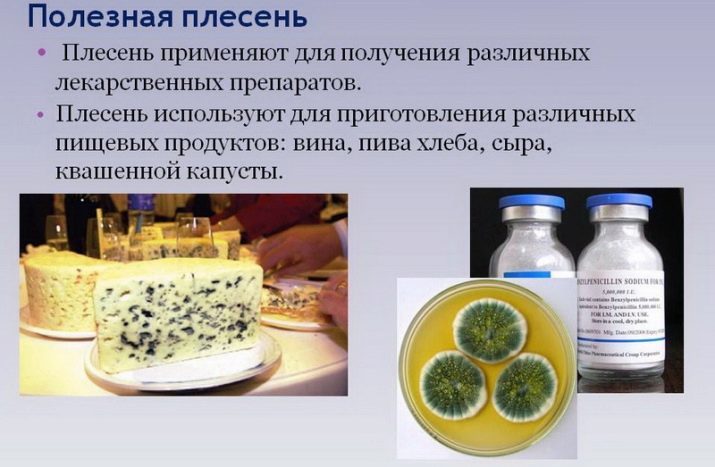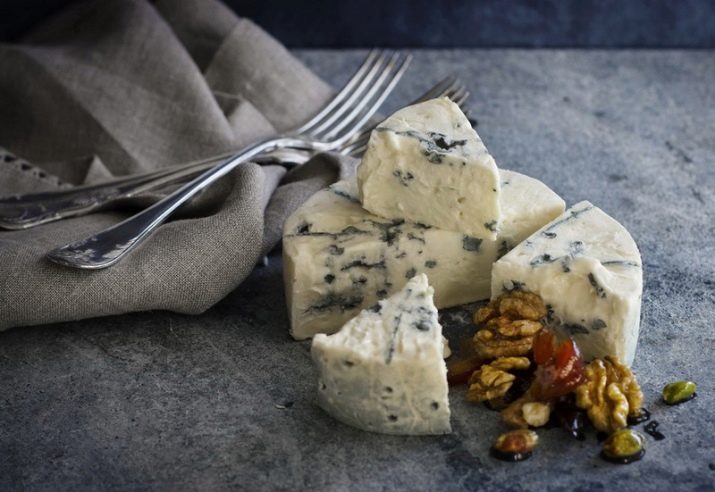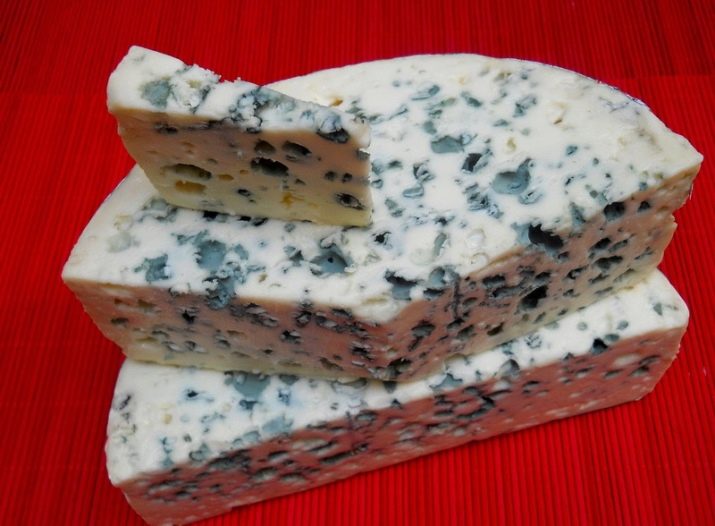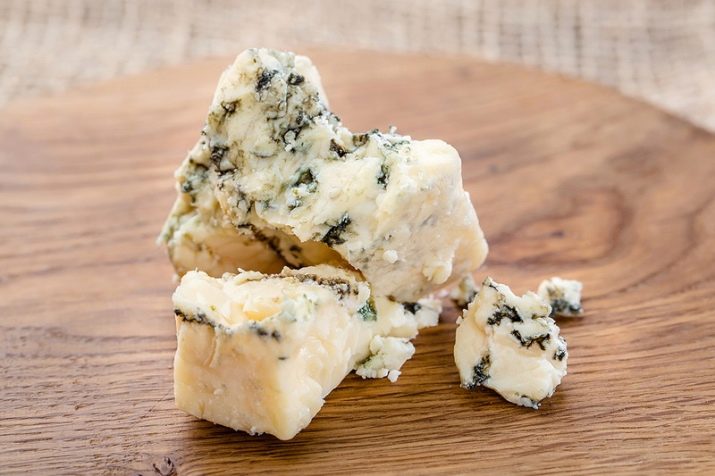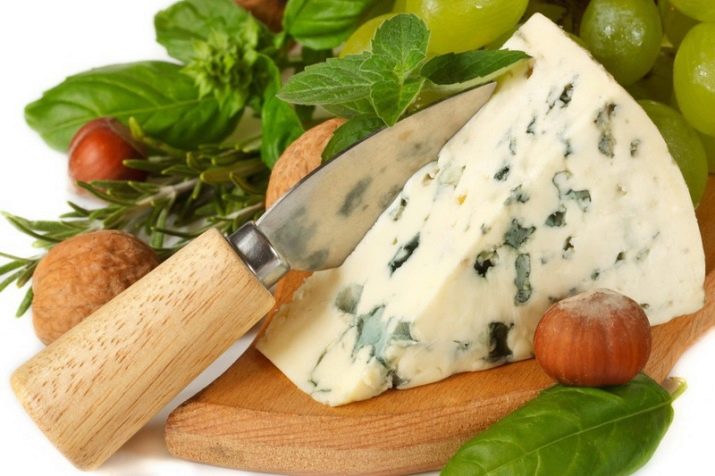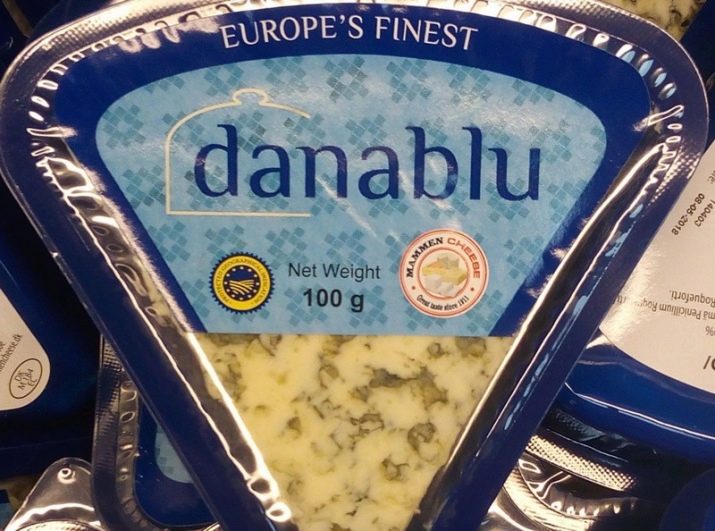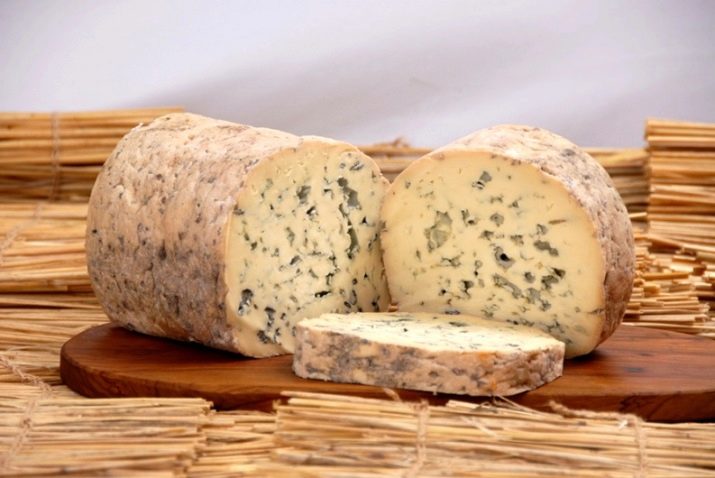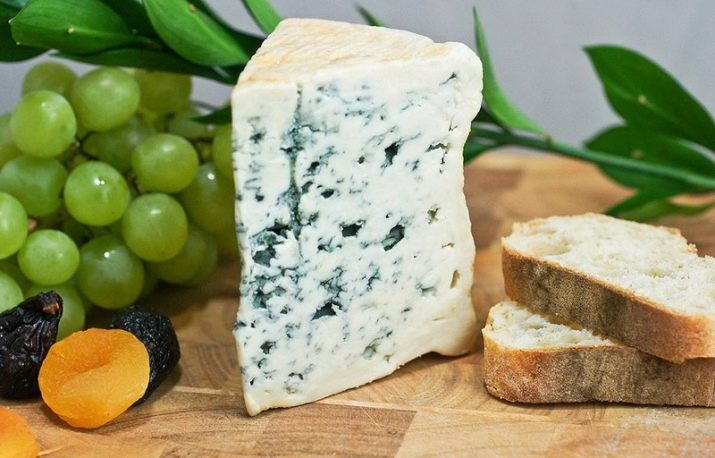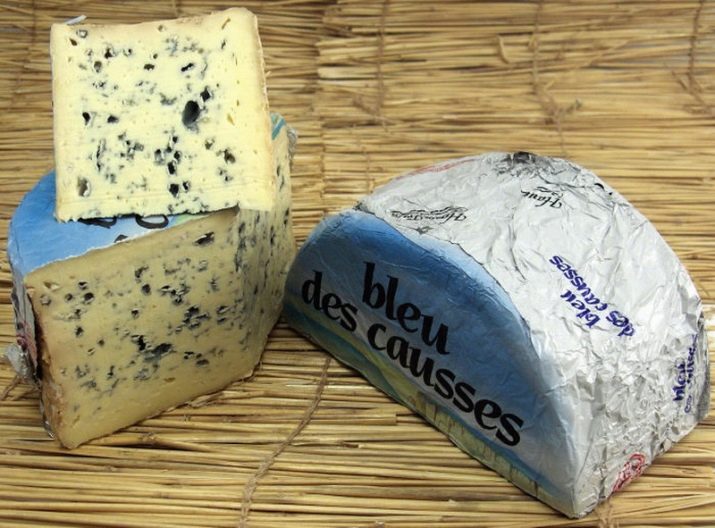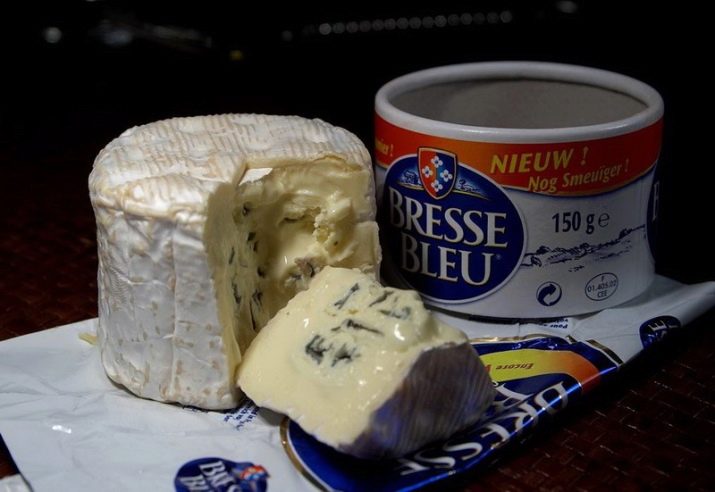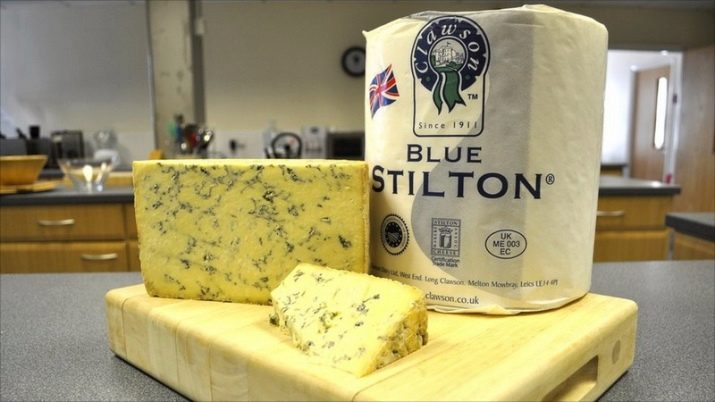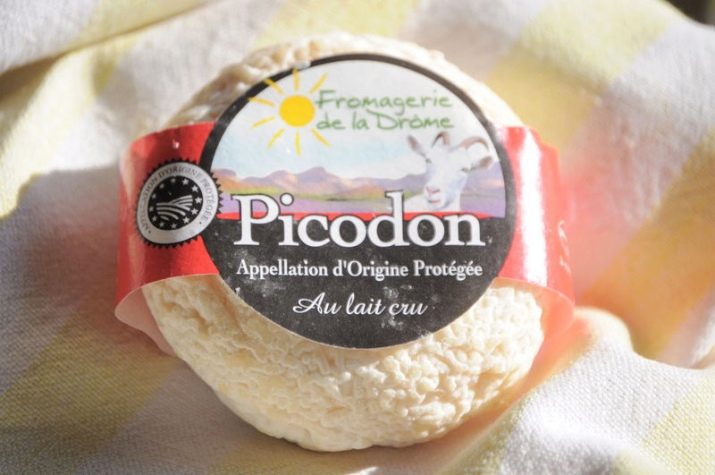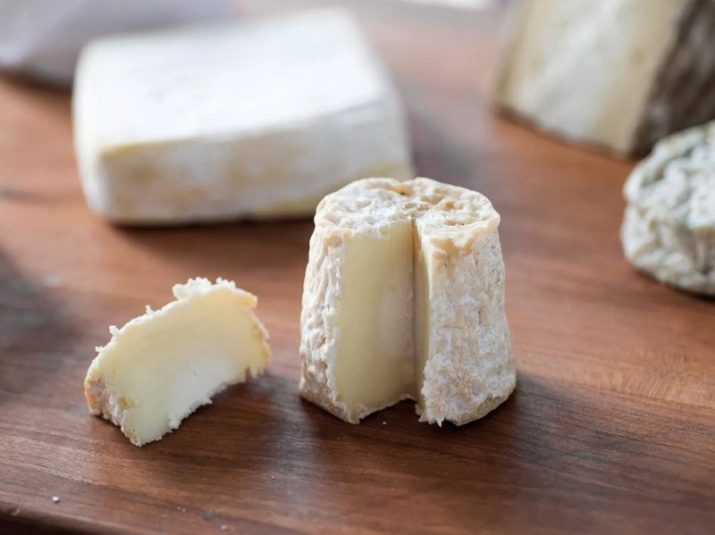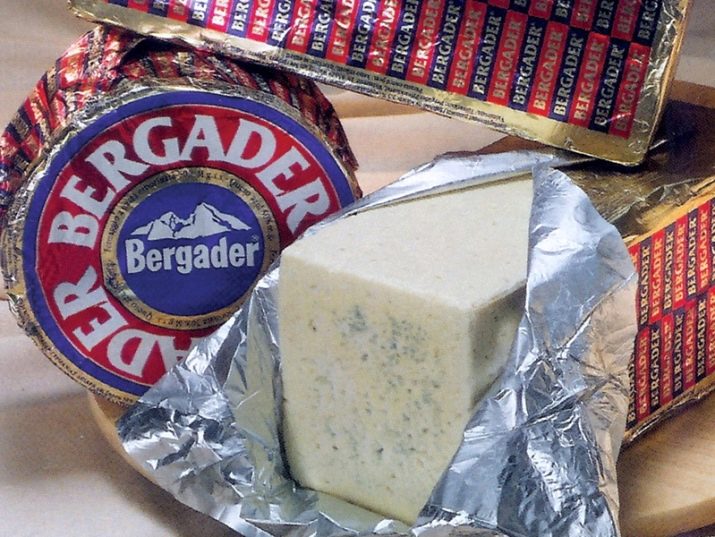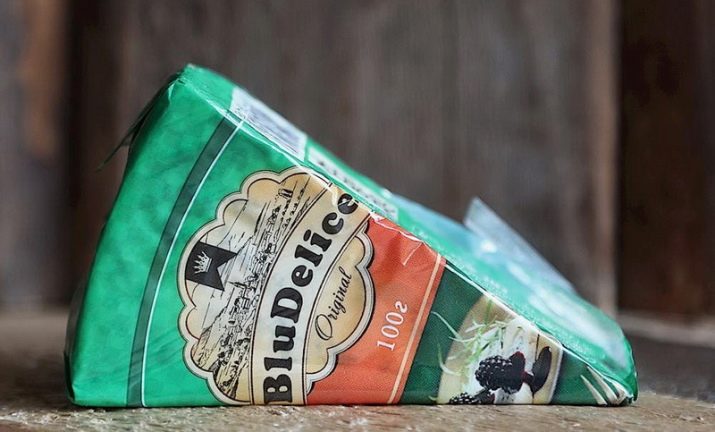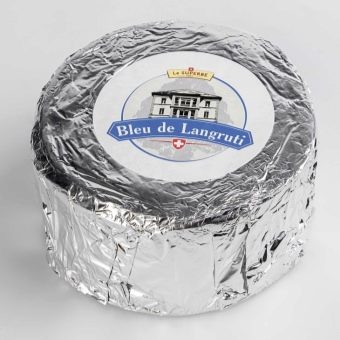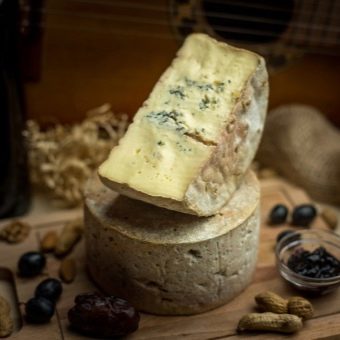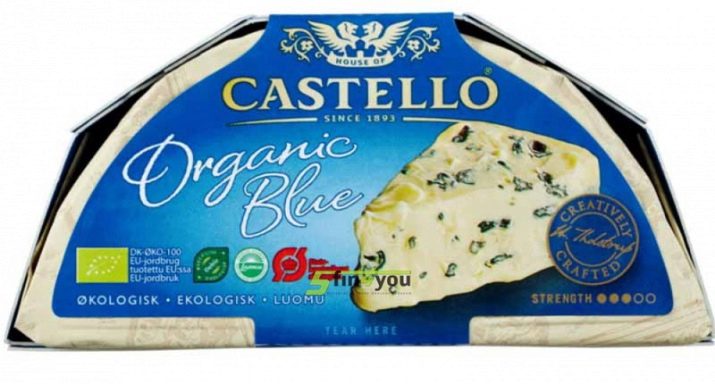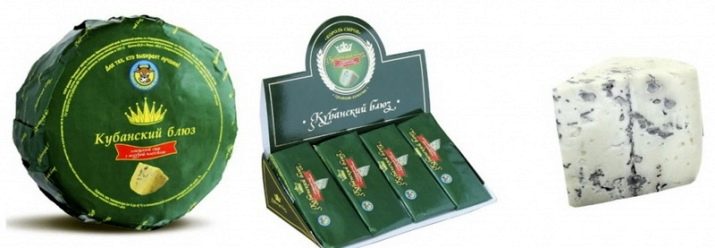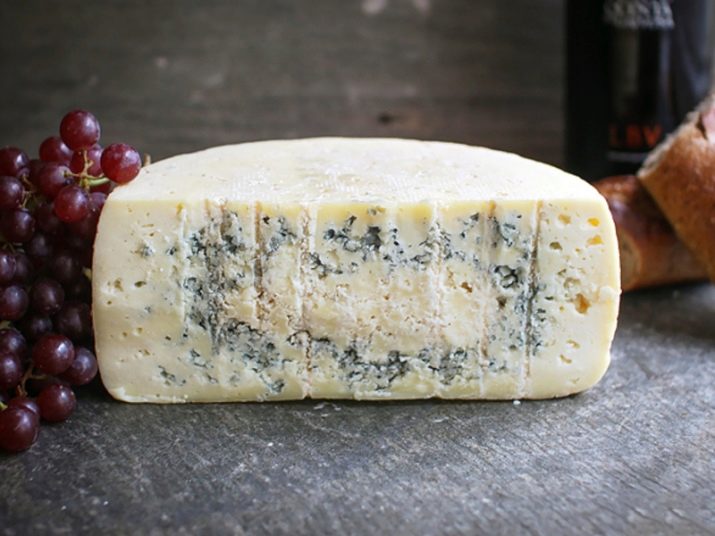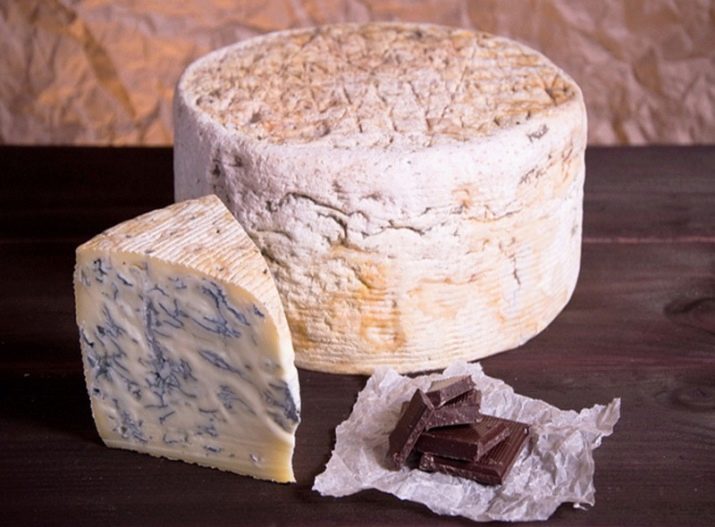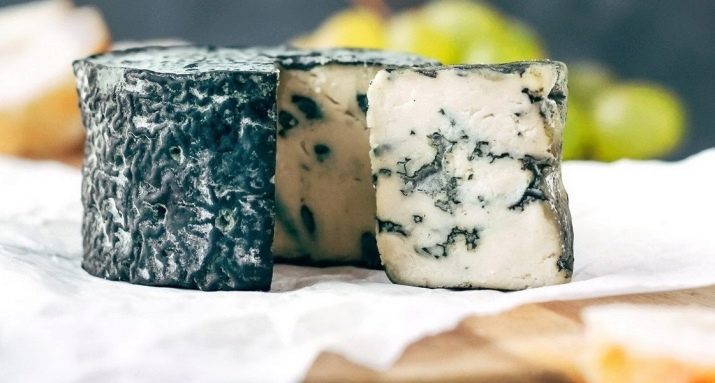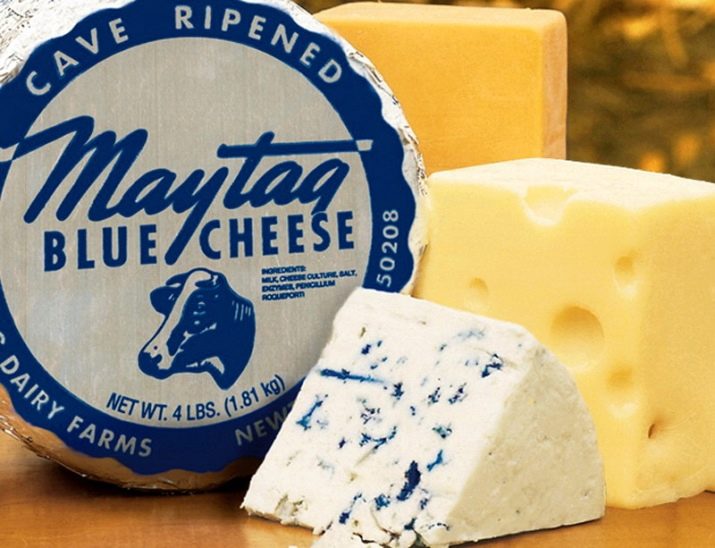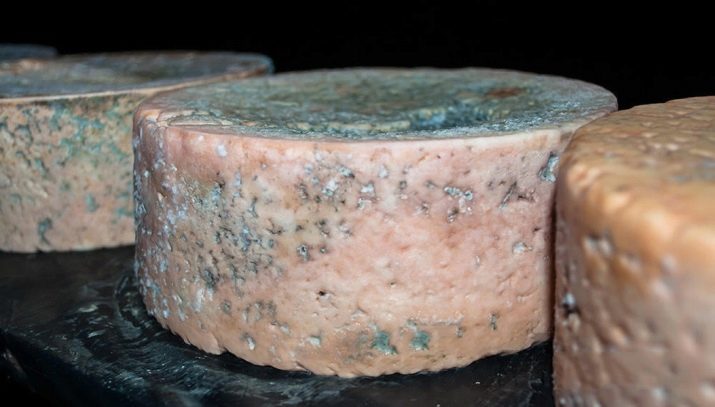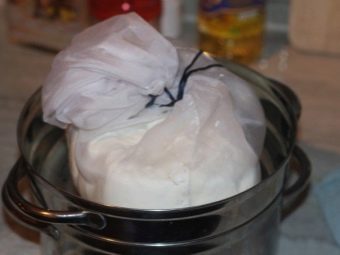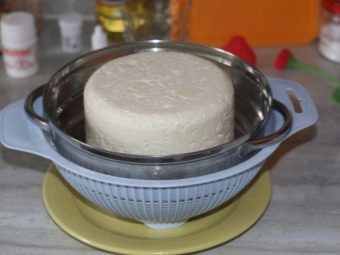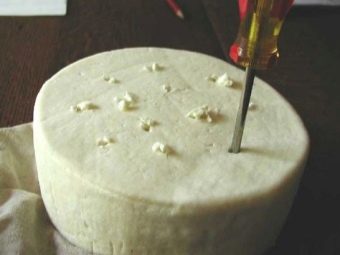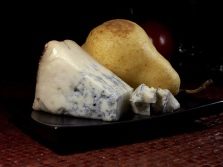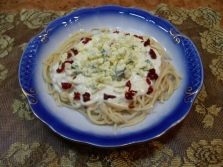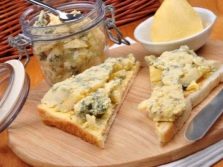Blue mold cheese: how to eat, good and harm, varieties
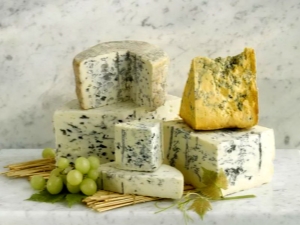
Cheese and gourmets say that cheese with blue mold is not only healthy, but also tasty.This is an unusual spicy-salty product that has a special production technology.
What it is?
The country of origin of this product is France. Blue mildew kernels in the cheese mass of a light beige color are associated with an unusual taste, and you can be sure of this by trying this cheese at least once.
The blue mold carries the scientific name Penicillium roqueforti. It contains penicillin. Penicillium Glaucum is also used. Interestingly, this is a fungus of natural origin (from caves), and not chemical, from the laboratory. In ancient times, rye bread was left in the caves for a long time. His pieces penetrated the natural moldy crust. Then they were crushed and added to the cheese mass.
There is a beautiful legend about the origin of cheese with blue mold. The shepherd herded sheep in the Roquefort mountains and saw a beautiful girl in the distance. He ran for excellent vision, leaving the bread and sheep milk cheese on the spot where he was standing - in a cave, his lunch. He searched for her for many days and weeks, and when he returned, he found his ration moldy. But hunger exhausted him so much that he attacked the spoiled cheese and ate it whole. He even liked the taste of cheese.
When choosing cheese you need to consider several aspects.
- Blue mold produces a peculiar odor. It resembles the smell of fresh mushrooms. Mossy aftertaste is also a characteristic feature of a quality product. If such cheese smells not like mushrooms, but ammonia, then its shelf life has expired or storage conditions have been violated.
- The appearance of the product should be attractive: blue streaks remind of stains on marble, turquoise inclusions are evenly distributed throughout the section. You should not buy cheese, if its surface is covered with mold, it is not a quality indicator.
Beneficial features
This is a highly nutritious cheese - 100 g of the product contains at least 350 kcal. So those who are on a diet and who want to lose weight should forget about including it in their daily diet. For ordinary people, this is a great snack. Nutritious and healthy product can be consumed without harm to health in the amount of not more than 50 g per day.
The benefits of cheese depend entirely on its composition.
- Amino Acids (arginine, tryptophan, valine, etc.) regenerate and rejuvenate tissues.
- High content of calcium and phosphorus helps to strengthen bones and joints, enrich the blood. This is especially valuable during pregnancy, when a woman needs an increased supply of the body with these substances. However, it is necessary to consume cheese at a minimum: excessive consumption of the product can cause a disease such as listeriosis.
- Lecithin beneficial effect on the state of the nervous system and digestion.
- Vitamin K dilutes the blood and promotes wound healing, stimulates the work of the heart muscle and blood vessels. During the period of PMS and in the case of a depressive state, such cheese will help activate the blood flow and will contribute to a better state of health.
Blue mold cheese is a way out for people who have an individual lactose intolerance. Due to the increased caloric content, it will contribute to building muscle mass. People seeking to acquire it quickly, including athletes and adapting after injuries, should emphasize the inclusion of such cheese in the diet.
In old age, it is useful to use blue cheese. In addition to the usual benefits, it will bring additional resistance in the fight against diseases such as atherosclerosis, osteoporosis, heart failure and others.
Contraindications and harm
You can not give this cheese and enter it in the diet in the following cases:
- young children under 12 are at risk of listeriosis - they are better off offering regular cheeses;
- during pregnancy and lactation, unstable hormones may change under the influence of the complex composition of the product;
- in case of a peptic ulcer of the digestive organs and gastritis, it is better to avoid cheeses with mold because of their high content of acid and salt;
- with high pressure you should not get involved in such cheeses, they are calorie and poorly digested;
- with asthma and asthma attacks;
- if there is a tendency to polyarthritis;
- with the development of fungal diseases (such as thrush);
- Allergy sufferers should carefully eat blue cheeses, at least they should start with minimal portions - from 10 g.
Sorta
Blue mold cheese varieties vary in consistency, salinity level, aging time, type of fungi used.
- Monty comes from France. "Cheese of kings and popes" is made from sheep's milk. Gentle pulp imbued with patches that may have bluish and turquoise hues. The process of making classic Roquefort is special: maturation is obligatory in a limestone cave, on oak shelves.
- Dorblu means "blue gold" in translation. German by origin, a variety of cheese with blue mold, has its history since 1908. It has a cream-colored flesh, resembling marble, with streaks of fungus. Today the leading producer of this variety is located in Lauben (Bavaria). The product is highly appreciated by gourmets around the globe.
- Gorgonzola (Gorgonzola) - Italian relative of Roquefort. One of the oldest in the world, began to be made in the IX century in natural caves near Milan. Today, more than 10 thousand tons are regularly exported to European countries. Legal licenses for the production of Gorgonzolla belong to only 2 provinces of Italy - like Lombardy and Piedmont.
- Danable comes from Denmark. It has a high fat content (about 50%) and has a rich salty taste. Began to be made more than 100 years ago on one of the islands belonging to Denmark. Pasty consistency does not allow to store it for a long time. Listed on the International List of Products that are Geographically Protected.
- Lance de amber manufactured from the time of the Roman Empire. Its production goes through 6 stages, typical for blue cheeses. This cheese is considered the most delicate in taste among all French. The name comes from the word "form", typical of this type of product (cheeses are made in the form of tall cylinders). Cylinder can pierce and infiltrate Madera or port.
- Bleu de Overn is sold in foil. Delicate plastic consistency distinguishes this cheese from the middle of the XIX century. It is considered an analogue of Roquefort, but made from cow's milk. Received widespread among the peasant population of the French region of Auvergne due to its availability.
- Bleu de coss - one of the varieties, which is produced from milk from cows of different breeds. It has a spicy taste, almost pepper. Under the orangish-white crust lies the ivory-colored flesh. For a long time it was called Bleu de Aveiron at the place of its first production. It is produced year-round, but the cheese produced in the summer months is more appreciated.
- Bleu de bresse - Blue Bresse cheese from France, ripening in 2-4 weeks. The classic version of the supplement for serving grape snails. It was first manufactured after the Second World War. Oily wet texture is especially attractive for gourmets.
- Stilton - a variety of blue cheese from WB. Nicknamed "cheese worthy of a sonnet." Began to be made in the first half of the XVIII century in the county of Leicestershire. In 1936, a whole association of producers of this cheese was created. Today, only 6 cheesemakers have a license. The variety differs in that only unpasteurized milk is taken for production.
- Tangi - special cheesebecause the basis of its production is not cow's milk, but goat's. The oily surface blends perfectly with the brackish taste and aroma of meadow herbs. It goes well with red wine, sherry, white and red port.
- Picadon is a southern French cheese. Translated means "sharp."Always done in the form of small and flat heads. Spicy and dry flesh has a smooth texture and a hard core. Picadon has a number of varieties that differ in acidity and processing features. A small patina of blue mold at Picadon covers only the crust.
- Shabishu du poitou, or just a shabishuIt is considered one of the oldest cheeses of this kind. According to legend, it began to be produced in the 8th century by the Saracens, who survived the battle of Poitiers in 732. Local peasants appreciated it. Cheese is made and sold not in the heads, but in the form of small cylinders, narrowed upwards. The grayish-blue tinge on the crust indicates the presence of mold.
- Bergader - German version of blue cheese. More than 100 years ago, in 1902, an ambitious German industrialist of the same name decided to create his own competitive version of Rokfor. This variety is especially recommended for adding to sauces and combining with slices of white bread. Its tart taste and characteristic blue streaks in the pulp managed to catch the fancy of the Russian consumer.
- Blue delis It has moldy inserts in the form of points and blotches in the pulp. Sharp and spicy taste and unsurpassed flavor make cheese the most suitable product for salads and appetizers to steaks, wines, pastes. Normal fat content (40-60%) gives the cheese a universal character. Today in Russia it is produced by the Allgoi company.
- Blue de Langruti is a variety from Switzerland. Spots of green and blue hue in the cheese mass - this is blue mold. Cheese cellars in the town of Langruti - the birthplace of cheese. It is there, in the sandstone, that the grafted, molded inclusions are fully revealed. The bitter aftertaste of this variety allows you to combine it with honey and even jam.
- Castello is a Danish brand of cheeses. In addition to blue, are made with white and even golden mold. Blue is always present inside, in the pulp. The taste is spicy and the smell of mushroom, in general, is very similar to such a variety as Gorgonzola. Fat content - 50-56%. May be produced as a creamy paste.
- "Kuban Blues" - a real Russian brand blue cheese, which has already won the hearts of many gourmet shoppers. Sold packaged in foil, under which lies the flesh of ivory with irregular thin veins, forming a ornate pattern. The taste of hazelnuts is what buyers characterize this cheese.
- Masta Blu is extravagant. It is made in Armenia. He has a heterogeneous mass - in the middle it crumbles, oily at the edges. Spicy-creamy taste and pleasant sourness - this is what distinguishes this variety.
- Mont Blue (or Monte Blun) - cheese, which is ideally combined with walnuts, cherry tomatoes, chocolate, radish, orange confiture. This variety of "satellites" helps to achieve a soft creamy tint with a sweet aftertaste. Prescription and technology recalls Gorgonzolla.
- Chizzy, or Blue Chizzy, on top is covered with a green shade film, which is a classic mold. Inside the pulp again has a bluish color. Red wine and fruit are suitable accompanying chizzy cheese during a meal.
- Mayteg (Maytag Blue) - American representative of blue cheeses. 1941, Wisconsin - the date and place of the beginning of its production. Aged 5 months. Good for serving with light white wines and citrus fruits.
- Cabral - comes from Northern Spain. Unpasteurized milk with added sheep - this is the source of Cabral. Spicy taste and strong sour aroma appear already in the early stages of production. Tradition required to sell this variety wrapped in white maple leaves. Modern industry has simplified this parameter to the foil.
How do you make a product?
For the preparation of cheese using cow's milk (only for Roquefort cheese - sheep). Coagulability of cow's milk occurs at a temperature of 30 ° C.The mass is placed in a mold that is covered with a wooden plate. Periodically for whey drip circles of the cheese turn from side to side. After 7-10 days they are turned upside down. The curved mass is rubbed with salt and pierced with syringes filled with moldy fungi — so blue streaks appear in the mass. The heads of the cheese are left “to ripen” for the mold to grow.
Blue cheese can be prepared at home. You need to take cottage cheese and a sample of any blue mold cheese for sourdough. Enough teaspoon. Sowing material is prepared using a blender, mixing moldy cheese with water. 2 spoons of salt are scattered on the cottage cheese laid out in a bowl, and the resulting starter is poured on top. Under a light press, the product is left overnight. In the morning you need to get the product and make holes in the mass every 2-3 cm. Then the surface is rubbed again with salt, wrapped in gauze and left for a month in a cool place.
How to eat?
Cheese with blue mold can be served to different drinks and used in different variations.
- As an independent snack. The best combinations are pears and grapes. An ideal way to accompany receptions with dry and semi-dry wines, for example, port.
- As an ingredient in cooking chicken wings, soups, pizza, sauces, pasta for spaghetti.
- As an element of pate. This cheese can be grind with butter and spread on hot white bread toasts or crispy biscuits.
Blue mold cheese is not a must-have product. It is rather a gourmet treat, than the usual product on the table of each of us. Unforgettable taste and quick feeling of satiety - the result of the inclusion in the diet of cheese with blue mold.
To learn how to make blue cheese at home, see the next video.

